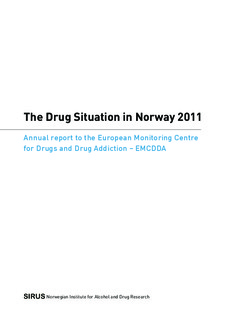| dc.contributor.author | Hordvin, Odd | |
| dc.contributor.author | Skretting, Astrid | |
| dc.date.accessioned | 2015-01-30T14:06:52Z | |
| dc.date.accessioned | 2015-02-11T19:41:42Z | |
| dc.date.available | 2015-01-30T14:06:52Z | |
| dc.date.available | 2015-02-11T19:41:42Z | |
| dc.date.issued | 2011 | |
| dc.identifier.citation | The Drug situation in Norway. 91 p. SIRUS, 2011 | |
| dc.identifier.isbn | 9788271713690 | |
| dc.identifier.uri | http://hdl.handle.net/11250/276008 | |
| dc.description | - | |
| dc.description.abstract | Decline in the use of cannabis
The most recent survey among the general population was carried out in 2009. A surprising matter in that survey was the relatively strong decrease since 2004 in the proportion that had used cannabis during the last 30 days in the under-35 age group. In 2004 it was 4.5 per cent, while in 2009 it was reduced to less than the half.
The 2010 survey, which included people aged 18-30 years, showed that cannabis is still the illegal drug that most young people report having tried (29 %). Significantly fewer have tried amphetamine and cocaine (approx. 6 % for both). Ecstasy and sniffing have been tried by nearly four and three per cent, respectively, while around one per cent of this age group report ever having used LSD, GHB and heroin.
Injecting users - stable situation
The number of injecting users in Norway has probably been quite stable since 2003.In 2009, it was estimated to be between 8,800 and 12,500. Heroin is still the most common drug injected, but, for around 17 per cent, amphetamines are the main drug injected.
Problem users of cocaine
SIRUS has in 2010/2011 participated in a project in which the amount of cocaine used in Oslo was calculated using three different methods. The Norwegian Institute for Water Research has carried out measurements of cocaine in wastewater, while the Norwegian Institute of Public Health has carried out measurements of cocaine among drivers suspected of driving under the influence. SIRUS has used a method based on the reporting of the frequency of cocaine use in four different surveys, both population-based and among inmates in prisons and injecting users. The results of the surveys have not yet been published, however.
In the questionnaire surveys, the respondents were also asked how often they used cocaine. It is thus possible to calculate an annual average number of cocaine users and the number of persons who used the drug more than once a week or more (problem users). On average for 2000-2009, there were approximately 1,800 problem users of cocaine per year in Oslo and 10,200 others who used the drug more rarely. The majority of the cocaine users, almost 50 per cent, were experimental users who had only used the drug one to four times during the last 12 months, while 35 per cent were recreational users (limited use). | |
| dc.description.abstract | Nedgang i bruk av cannabis
Den siste undersøkelsen i den generelle befolkningen på bruk av cannabis ble gjort i 2009. Et overraskende funn her var den forholdsvis kraftige nedgangen i gruppen yngre enn 35 år som hadde brukt cannabis i løpet av siste 30 dager. I 2004 var denne gruppen på 4,5 prosent, mens den i 2009 var redusert til under halvparten.
En undersøkelse fra 2010 som inkluderte aldersgruppen 18-30 år, viste at cannabis fortsatt er det rusmidlet som flest ungdommer rapporterer å ha prøvd (29 %). Langt færre har prøvd amfetamin og kokain (ca 6 % for begge stoffene). Ecstasy og sniffing har vært prøvd av nær fire og tre prosent, mens rundt en prosent i denne aldersgruppen rapporterer å noen gang ha brukt LSD, GHB eller heroin.
Stabilt antall injeksjonsmisbrukere
Antall injeksjonsmisbrukere ser ut til å ha vært stabilt siden 2003. I 2009 ble det estimert et antall på mellom 8800 og 12000 injeksjonsmisbrukere i Norge. Heroin er fortsatt det vanligste rusmidlet å injisere, men for ca 17 % er amfetamin det som hyppigst injiseres.
Problembrukere av kokain
SIRUS deltok i 2010/2011 i et prosjekt der man gjennom tre ulike metoder forsøkte å måle omfanget av kokainbruk i Oslo. Norsk Institutt for Vannforskning har foretatt målinger av kokain i avløpsvann, mens Folkehelseinstituttet har beregnet forekomst av kokain hos ruspåvirkede sjåfører. SIRUS har brukt en metode basert på frekvensen av kokainbruk i fire forskjellige undersøkelser, både befolkningsbaserte, blant innsatte i fengsler og blant injeksjonsmisbrukere. Resultatene fra undersøkelsene har ikke ennå blitt publisert.
I spørreundersøkelser har respondentene også blitt bedt om å oppgi hvor ofte de bruker kokain. Det er derfor mulig å anslå antall kokainbrukere samt antallet som bruker rusmidlet mer enn en gang i uken (problembrukere). I gjennomsnitt for årene 2000-2009, var det om lag 1 800 problembrukere av kokain i Oslo og 10 200 som hadde brukt rusmidlet sjeldnere. Majoriteten av kokainbrukerne, om lag 50 prosent, var eksperimentelle brukere som hadde brukt kokain én til fire ganger i løpet av det siste året, mens 35 prosent ble regnet som rekreasjonsbrukere (begrenset bruk). | |
| dc.language.iso | eng | |
| dc.relation.uri | http://www.sirus.no/filestore/Automatisk_opprettede_filer/Drug_Situation_Norway_2011.pdf | |
| dc.title | The Drug Situation in Norway 2011 : Annual report to the European Monitoring Centre for Drugs and Drug Addiction - EMCDDA | |
| dc.title.alternative | Narkotikasituasjonen i Norge 2011 | |
| dc.type | Research report | |
| dc.date.updated | 2015-01-30T14:06:52Z | |
| dc.identifier.cristin | 909899 | |
